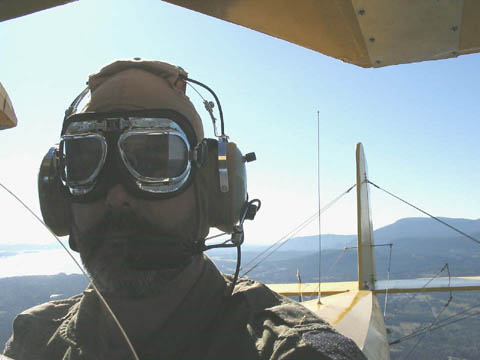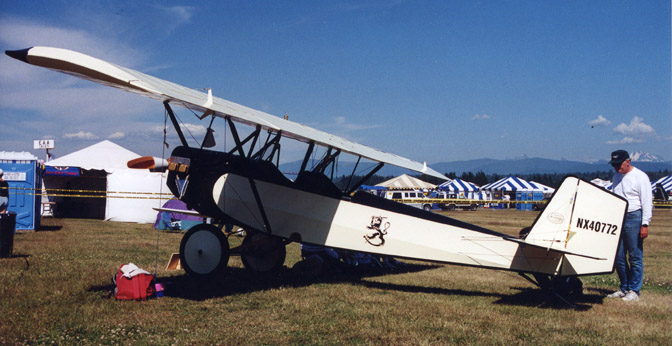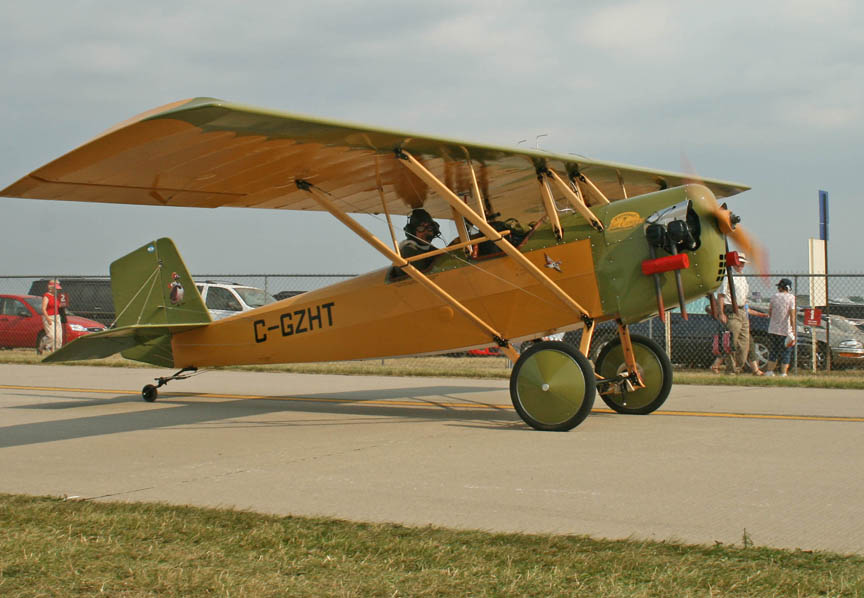
[RJW comment] One question I often get is, "Which is better, the Fly Baby or the Pietenpol?" It's probably an obvious question; the two planes are nearly identical in philosophy (open cockpit, wooden fun airplanes) and most people contemplating building a Fly Baby are probably considering the Piet as well.
Every time this happens, I have to tell myself: This is not a competition. Either makes a good fun homebuilt aircraft. Fly Baby fanatic that I am, I am biased, but think the Piet's a good little plane. I'm reminded of that song from "Oklahoma": "The Farmer and the Rancher Should be Friends." The decisions seem about evenly split; there are about the same number of Piets on the FAA registry as Fly Babies.
I knew there were some folks on the Fly Baby mailing list who had flown both types. So I asked for comments, and Drew Fidoe came through. Links and some specifications at the end.
Oh, and if anyone in the Pietenpol community wishes to write a rebuttal, I'll be happy to add it here....I'd prefer it, of course, if the individual had experience in both types of aircraft.
Drew Fidoe's Comments:
 I’ve flown two
different A-65 powered Fly Babies, and short-fuselage
Pietenpol Air Camper built to the original Bernie Pietenpol
plans, which was originally powered with Model A Ford and
later with a Continental O-200.
I’ve flown two
different A-65 powered Fly Babies, and short-fuselage
Pietenpol Air Camper built to the original Bernie Pietenpol
plans, which was originally powered with Model A Ford and
later with a Continental O-200. My notes here are based on the O-200 powered Pietenpol. The Model A Ford powered Ford powered Piet is in a different class from Fly Baby in the context of this discussion.
Control:
Roll: Fly Baby is lighter on aileron with less adverse yaw than a Piet. The Piet’s ailerons are stiffer with a notably slower roll rate.
Pitch: The Piet that I fly is more sensitive in pitch than Fly Baby.
Yaw: both machines are about the same in rudder sensitivity, however the old-school rudder bar of the Piet gives a “mind-muscle” feel that takes some getting used to.
Power:
The Pietenpol that I fly seems happiest flying at around 70 mph. With the O-200 fitted it will go faster but the machine get jittery and cockpit noise and wind unpleasant. Also, with the 100 horse power there feels to be “flex” in the fuselage at high power in climb-out.
Talking of 100 hp in a Piet, this is overpowering this ship. From talking to other Pietenpol pilots, 65 hp is a perfectly good fit for the airframe. I would expect a Fly Baby to cruise about 10% faster than a Pietenpol on the same A-65, but would expect better power and climb from the Pietenpol (flown solo anyhow) on the same power. I think the Piet is a good choice for alternate engines.
Handling:
The Piet glides reasonably well even with round-tube struts, has pleasant power off handling, and tends to float a bit more on landing that the Fly Baby. At low speeds, Fly Baby can develop a significant sink rate.
The Piet lands at a lower speed than Fly Baby. I found the Piet requires a lot more attention and respect in the transition between flying and taxi speed. The Piet is more challenging to land than a Fly Baby, but both require respect. The low wing of the Fly Baby, along with its fixed geometry landing gear, give it a pleasant and very predictable ground handling. Yaw momentum is reasonably light for both types.
Setting up brakes in a Piet equipped with a rudder bar can be a challenge, and the Piet is lighter in the tail than a Fly Baby thus care must be taken when applying brakes and during engine run-ups. The Piet that I fly is more of a challenge to land, especially on pavement. It has a split axle bungee landing gear which has reasonably good geometry, but the machine can be squirrelly especially in crosswind, where cross winds can give the aeroplane a list making directional control a challenge. In comparison, I find crosswind handling in a Fly Baby fun! The Piet I fly feels tipper on the ground (and downright top heavy when fitted with the water cooled Ford engine).
Fly Baby is generally more stable, especially in rough airs. It can be flown in anything that a general aviation light aircraft can tackle. On the other hand, I find the Pietenpol does not like turbulence, and can be a tiring workout in weather that doesn’t faze a Fly Baby. I consider the Pietenpol more of a well built, pre-historic ultralight with emphasis on ultralight when considering operation in wind and turbulence.

Structure:
Ergonomics and Cockpit View:
The pilot is better protected from the wind and elements in a Fly Baby with its deeper cockpit and choice of windshields (and canopy). There is more room for instruments and equipment in a Fly Baby and the instrument panel is closer to the pilot’s line of sight making it easier to monitor instruments in critical phases of flight.
The Pietenpol that I fly is the short fuselage version (there three versions, the longer ones apparently affording a bit more rear cockpit room). The seat on the Piet is structural, so more attention must be made to ergonomics during construction. There is a bulkhead in the Piet separating the two cockpits with penetrations cut for the pilot’s feet to access the rudder bar. These can be opened up but some find it restrictive.
The rudder bar, and the ergonomics of how your legs must move to operate the rudder takes some getting used to compared to more modern rudder pedals like in a Fly Baby. The cockpit of the Piet feels a lot tighter than a Fly Baby and it is definitely windier. The pilot’s increased exposure in the Piet means that I do not fly it in cool weather while I fly my Fly Baby in temperatures down to freezing with relative comfort.
Access to the rear cockpit of a Piet is difficult if no fillet or access flap is fitted in the wing trailing edge. The front cockpit in the Piet is extremely tight to get into, especially if not fitted with the forward cabanes eliminating one of the x-brace wires at the front cockpit. There is no door for the front ‘pit making ingress and egress more of an adventure in aeroplane yoga. Some folks raise the wing a few inches for more headroom and better front cockpit access.
That said, did I mention that the Pietenpol has a front cockpit? :)
Visibility in the 3-point is better in a Fly Baby than a Pietenpol, and in a turn the unlimited visibility is appreciate. The Piet on the other hand is blind as a bat in a turn but I really appreciate the view downward when puttering along watching the world drift by. There is room for storage in Fly Baby, in the baggage compartment and many folks add an extra shelf below that. The Piet has very little storage… unless you fly solo and then you have oodles of space to stow your gear.

Summary:
Overall, Pietenpol feels of a different era and demands respect. The ergonomics are fair but not great as long as you aren’t a generously large person. It is slower than most modern aircraft and the controls aren’t overly well balanced…but don't get me wrong, it's still FUN!
You can carry lots of stuff in the front hole, or squeeze in a passenger. It has pleasant low speed handling and unobstructed view downward. Looking around you and seeing all those wires, watching the aileron cables move in union with the joystick… keeping the ball centered while making figure eight turns and hitting your own wake... the fresh air… the unrestricted downward view… very retro, and very rewarding flying.
If cockpit size and speed isn’t an issue, a conservative alternate engine is desired, the view downward is a priority, or you want to take a friend along for a local hop and no desire to get anywhere in a hurry… the Piet is a great choice. Think of it as a nostalgic 20’s retroship.
If cockpit size, comfort from wind, and cold weather flying is important, Fly Baby is a great choice. Fly Baby is also proven as a fair cross country ship, with pleasant handling both in flight and on the ground, and is great for general fun-flying yank n’ bank visibility. Fly Baby is a good, tough machine who’s design is tolerant to modifications for aesthetic and cockpit ergonomic reasons. Think of the Fly Baby as 1930’s training plane.
